In late December 2012, the fourth and final phase of the $300,000 Penn Museum Luce Program to Strengthen Southeast Asian Archaeology begins. Its focus is Luang Prabang Province, Laos, where the Museum’s Middle Mekong Archaeological Project (MMAP) has conducted surveys, test excavations, and related multi-disciplinary studies since 2005.
Highlights of the MMAP 2013 Season
Climate change research via speleothem studies lead by Dr. Kathleen Johnson (UC, Irvine) and team.
 One of the pioneering aspects of MMAP has been incorporation of paleoclimate research. In 2010, Dr. Johnson’s team began to reconstruct past variability in Asian monsoon rainfall using data from stalagmites collected in 3 Lao caves in the MMAP study area. Speleothem studies give us an “HD” look at paleoclimate change: we can see climate changes over single generations of ancient peoples as well as look at changes over millennia. This research promises to show ways that climate changes correlated to changes in cultural practices during the time period that MMAP is finding archaeological evidence of human settlement in northern Laos [Regular seasonal rainfall is critical to sustain life in this region, and any slight variations in its strength and/or timing likely had big impact on prehistoric Lao settlements.]
One of the pioneering aspects of MMAP has been incorporation of paleoclimate research. In 2010, Dr. Johnson’s team began to reconstruct past variability in Asian monsoon rainfall using data from stalagmites collected in 3 Lao caves in the MMAP study area. Speleothem studies give us an “HD” look at paleoclimate change: we can see climate changes over single generations of ancient peoples as well as look at changes over millennia. This research promises to show ways that climate changes correlated to changes in cultural practices during the time period that MMAP is finding archaeological evidence of human settlement in northern Laos [Regular seasonal rainfall is critical to sustain life in this region, and any slight variations in its strength and/or timing likely had big impact on prehistoric Lao settlements.]
Dr. Johnson’s study is the first long record of Lao paleoclimate change ever undertaken. Preliminary data (3 cave sites) covers the entire Holocene/Deglacial and some of the glacial (> 50,000 years). Next step begins during the MMAP 2013 season: fill in more speleothem data for the past 20,000 years and correlate this with MMAP archaeological finds/indications of changes in cultural practices. Dr. Johnsons’s 2013 team includes veteran caver/speleothem researchers who will be exploring more challenging caves than those sampled in 2010.
Other collaborations/activities during this MMAP season
Analyze plant remains, shell and animal bone remains, and ceramics excavated in previous MMAP seasons. Refine GIS data and improve MMAP database; take DNA samples.
2013 Team
The MMAP 2013 Survey Team was a collaboration of U.S., Lao, British, Australian, Cambodian, Filipino, and Thai colleagues.
 Andrea Borsato (Italy) Museo delle Scienze
Andrea Borsato (Italy) Museo delle Scienze
Khammeung Boudthavixay (Laos) UNESCO Office of Cultural Heritage – Plain of Jars Division of Information and Culture, Xieng Khouang, Lao PDR
Sureeratana (Joom) Bubpha (Thailand) Lecturer, Thammasat University, Bangkok
Nattha Chuenwattana (Thailand) Archaeobotanist, University of Toronto
Silvia Frisia (Italy) University of Newcastle
Dr. Elizabeth Hamilton (USA) Researcher, University of Pennsylvania Museum
Shawn Hyla (USA) Senior Information Technology (IT) Specialist, University of Pennsylvania Museum
Dr. Kathleen Johnson (USA)Assistant Professor, Earth System Science School of Physical Sciences University of California, Irvine
Samnang Kim (Cambodia)APSARA (GIS Consultant)
Sengphone Keophanhya (Laos) National Museum, Luang Prabang
Nouphanh (Nou) Keosouda (Laos) National Museum, Luang Prabang
Bounpone Lasi (Laos)Culture Section official, Oudomxay Province
Dr. Helen Lewis (Ireland) Lecturer, University College Dublin
Rhuet (Mu) Nakchuen Archaeological Illustrator
Onchansamone (Onchan) Ninethaphone (Laos) Luang Prabang District, Office of Information and Culture
Freda Oppenheimer (United Kingdom) Oxford University
Stephen James Oppenheimer (United Kingdom) Oxford University
Kon Keo Phannasy (Laos) Artefact Protection Office, Luang Prabang Province, Department of Information and Culture
Philip Piper (United Kingdom) Australian National University, Canberra
Fredeliza Campos Piper (Philippines) Australian National University, Canberra
Sangmany Sananekhom (Laos) National Museum, Vientiane
Norseng Sayvongdouane (Laos) Technical Staff, Cultural Section, Department of Information and Culture, Luang Prabang Province
Sysouphonh Singphaseuth (Laos) National University of Laos
Souksamone (Pong) Sonethongkham (Laos) Staff, Lao National Museum, Vientiane
Khamphet Souvannalath (Laos) Lao National Museum, Vientiane
Beth Van Horn (USA)Volunteer, University of Pennsylvania Museum
Phousavanh (Phou) Vorasing (Thailand) UNESCO Office of Cultural Heritage – Plain of Jars, Xieng Khouang Peerayot Sidonrusmee UNESCO, Bangkok
Hongying Yang (China) Research Assistant, University of California, Irvine
{/vc_column_text]
- Read the blog by Amy Ellsworth: MMAP 2010: A Virtual Excavation in Laos
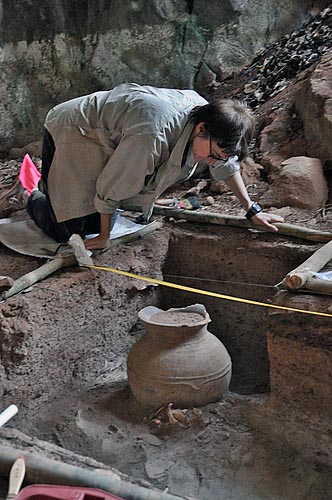
- Watch the Vimeo video by Amy Ellsworth: A video interview of Co-director Dr. Joyce White
During the 2010 season, the MMAP team excavated a cave site called Tham An Mah that was used in historic times as a Buddhist temple and, judging from its location and surface finds, also had the potential for good prehistoric material. A team of international experts will be researching other facets of the site. Excavation produced several Iron Age burials, some of which were unique for this area.
Climate Change Research
Two experts from University of California, Irvine (Kathleen Johnson) and Australia (Michael Griffiths) conducted speleothem research in the deep caves around Luang Prabang. Speleothems are the technical name for what we nongeologists call stalagmites, stalagtites, and flowstone. They drilled into the speleothem layers to take core samples; later in the lab they will examine the thickness and mineral content of the individual layers in an attempt to reconstruct thousands of years of climate and climate change.
Archaeobotany
Under the supervision of Dr. Gillian Thompson from the University of Bradford in the U.K., the team performed flotation on the soil from Tham An Mah in order to extract and identify seeds and other plant remains from prehistoric contexts.
Capacity Building
The team continued to train Lao archaeologists, not only in excavation, but in survey and analysis. The goal was to leave the Laos with a working database system and training so that they can do their own survey work when we are gone and put the new site data into the same tables. This will allow them to maintain a comprehensive and standardized system for site recording.
2010 Team
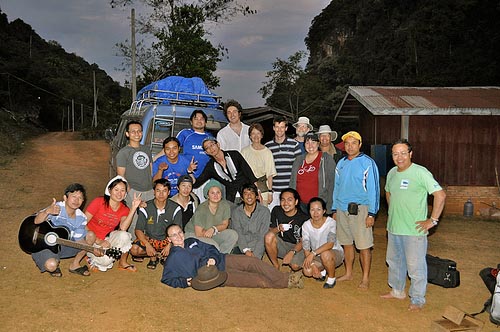 Korakot (Kot) Boonlop Researcher, Princess Maha Chakri Sirindhorn Anthropology Centre (SAC), Bangkok, Thailand
Korakot (Kot) Boonlop Researcher, Princess Maha Chakri Sirindhorn Anthropology Centre (SAC), Bangkok, Thailand
Khammeung Boudthavixay UNESCO Office of Cultural Heritage – Plain of Jars Division of Information and Culture, Xieng Khouang, Lao PDR
Souliya Bounxaythip Division of Archaeological Research, Ministry of Information and Culture, Laos
Michael DeWald Volunteer, University of Pennsylvania Museum, USA
Sisomseun Doungsuliya Senior Geologist, Lao Department of Energy and Mines, Laos
Amy Ellsworth Digital Media Developer, University of Pennsylvania Museum
Michael Griffiths Graduate Student, University of Newcastle, Australia
Dr. Elizabeth Hamilton Researcher, University of Pennsylvania Museum, USA
Stephanie Howton Volunteer, Archaeology Student, University of Newcastle, Australia
Dr. Kathleen Johnson Assistant Professor, Earth System Science School of Physical Sciences University of California, Irvine, USA
Sengphone Keophanhya National Museum, Luang Prabang, Laos
Nouphanh (Nou) Keosouda National Museum, Luang Prabang, Laos
Suthone Ketphanh MMAP consultant, Lao Forestry Department, Laos
Bounpone Lasi Culture Section official, Oudomxay Province, Laos
Dr. Helen Lewis Lecturer, University College Dublin, Ireland
Rhuet (Mu) Nakchuen (Thailand) Archaeological Illustrator
Onchansamone (Onchan) Ninethaphone Chief of Culture for Luang Prabang District, Department of Information and Culture, Laos
Kon Keo Phannasy Artifact Protection Office, Luang Prabang Province, Department of Information and Culture, Laos
Patrizia La Piscopia Graduate Student at University College Dublin, Ireland
Emil Robles Graduate Student at University of the Philippines, Manila
Sangmany Sananekhom National Museum, Vientiane, Laos
Norseng Sayvongduoane Deputy Director, Department of Information and Culture, Laos
Souksamone (Pong) Sonethongkham Staff, Lao National Museum, Vientiane, Laos
Gillian (Jill) Thompson Lecturer, University of Bradford, UK
Phousavanh (Phou) Vorasing UNESCO Office of Cultural Heritage – Plain of Jars Division of Information and Culture, Xieng Khouang, Lao PDR
Some of the MMAP team members present papers at the Indo-Pacific Prehistory Association (IPPA) conference
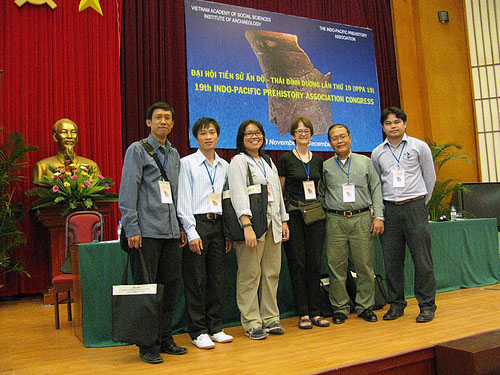 Read the abstracts: MMAP Team ABSTRACTS—2009 IPPA Conference, Hanoi
Read the abstracts: MMAP Team ABSTRACTS—2009 IPPA Conference, Hanoi
MMAP team members traveled to Hanoi in late November 2009 to present papers at the Indo-Pacific Prehistory Association (IPPA) conference. The IPPAs are the most important conference meetings for Southeast Asianist archaeologists in the world, with over 500 participants. These meetings occur only once every three to four years, so the 2009 conference was an important place to report on MMAP progress from the previous three years of field work and training seasons.
Nine MMAP team members presented papers: MMAP co-directors Joyce White and Bounheuang Bouasisengpaseuth, Lao team members Phousavanh (Phou) Vorasing, Souksamone (Pong) Sonethongkham and Sengphone Keophanhya, Thai team members Korakot (Kot) Boonlop and Sureeratana (Joom) Bubpha, Ben Marwick (University of Washington) and Helen Lewis (University College Dublin).
Highlights of the IPPA Presentations
In 2010, MMAP marks its tenth year of archaeological research in Laos, and the presentations by the co-directors provided broad views of the MMAP project.
Joyce White gave an overview of MMAP: its history, what it had accomplished so far, and its future plans. She reported that – as of July 2009 – the MMAP surveys had documented 69 archaeological sites in the area around Luang Prabang and had excavated three sites with dates ranging from the end of the Ice Age to the historic period.
Bounheuang Bouasisengpaseuth aimed his talk at archaeologists seeking to work in Laos, discussing the requirements of obtaining excavation permits and MOUs (Memorandums of Understanding) from the Lao government.
Three Lao team members were first-time presenters of scholarly papers, and they built upon their MMAP training in scholarship and public communication and their knowledge of Lao culture to bring special perspectives to the conference.
Phousavanh (Phou) Vorasing, in a talk that received praise from senior archaeologists at the conference, reported on the results of his ethno-archaeological investigation of shell remains uncovered in three MMAP excavations. Phou studied the shell species found archaeologically, and conducted interviews in the street markets of Luang Prabang with women who collect and sell snails and other shelled species. By doing this, he was able to get an idea of the relative abundance and collecting season of each species found in the prehistoric sites.
Sengphone Keophanhya, who works at the Palace Museum in Luang Prabang, gave a presentation on MMAP and Lao cultural heritage, concentrating on an evaluation of the MMAP training program for Lao cultural heritage staff that took place in early 2009.
Souksamone (Pong) Sonethongkham used his 2009 training in rock type identification and stone tool recording to present findings about variations in stone tool cores found in three rock shelter sites excavated by MMAP. Using data from the excavated sites, Joyce White and Pong had discovered that there were real differences among MMAP sites in the kind of stone used for core tools—the first time anyone had ever looked at those kinds of distinctions in Southeast Asian hunter-gatherers.
Other MMAP Papers
Korakot (Kot) Boonlop and Sureeratana (Joom) Bubpha co-authored a paper about MMAP as the first implementation in Southeast Asia of true cross-borders scholarship in the Middle Mekong region.
Helen Lewis discussed scholarly issues having to do with choosing the most promising archaeological sites for excavation, based on various criteria such as the shape of a cave and artifacts found at the surface of the cave.
Ben Marwick of the University of Washington reported results of his geoarchaeological analysis of sediments excavated from Tham Sua, the site which MMAP excavated in July 2009. This analysis revealed imporant information about site formation processes and stratigraphic integrity.
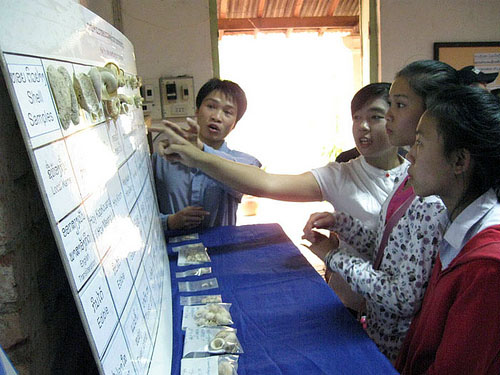 Read the article: “MMAP 2009″
Read the article: “MMAP 2009″
In 2009, the Middle Mekong Archaeology Project (MMAP), directed by Joyce White, received the first installment from the Henry R. Luce Foundation of a $300,000 four-year grant to advance Southeast Asian collaborative archaeology. The nine-week training program in Luang Prabang, Laos, was conducted in two parts, both focusing on developing modern archaeological skills among Lao and Thai heritage managers. In June 2009, a two-week training excavation took place at Tham Sua (Tiger Cave). In February and March 2009 practicums were conducted by foreign and Lao experts in archaeological database management, computer skills, stone identification, GIS and mapping, lithic analysis, archaeological illustration and photography, archaeobotanical analysis, and exhibition development, all using MMAP data. At the same time the team members were conducting site survey using mobile GIS technology, adding eleven new sites to the MMAP total.
The skills acquired in database entry, stone analysis, and shell analysis resulted in the presentation of three papers by MMAP trainees at the 2009 meetings of the Indo-Pacific Prehistory Association in Hanoi.
2009 Team
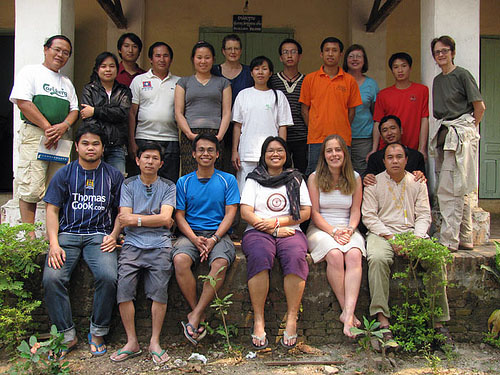 Dr. Katherine Arrell Lecturer in Geography, University of Leeds, UK
Dr. Katherine Arrell Lecturer in Geography, University of Leeds, UK
Dr. Huw Barton Lecturer, University of Leicester, UK
Korakot (Kot) Boonlop Researcher, Princess Maha Chakri Sirindhorn Anthropology Centre (SAC), Bangkok, Thailand
Souliphan Bouaraphan Division of Archaeological Research, Ministry of Information and Culture
Khammeung Boudthavixay UNESCO Office of Cultural Heritage – Plain of Jars Division of Information and Culture, Xieng Khouang, Lao PDR
Souliya Bounxaythip Division of Archaeological Research, Ministry of Information and Culture, Laos
Sureeratana (Joom) Bubpha Lecturer, Thammasat University, Bangkok, Thailand
Andy Cowan Graduate student, University of Washington, USA
Dr. Elizabeth Hamilton Researcher, University of Pennsylvania Museum, USA
Shawn Hyla Senior Information Technology (IT) Specialist, University of Pennsylvania Museum, USA
Phonepeth Joumlamounty Division of Geological Survey and Mines 1, Department of Geology, Ministry of Energy, Lao PDR
Sengphone Keophanhya National Museum, Luang Prabang, Laos
Nouphanh (Nou) Keosouda National Museum, Luang Prabang, Laos
Onchansamone (Onchan) Ninethaphone Luang Prabang District, Office of Information and Culture, Laos
Kon Keo Phannasy Artefact Protection Office, Luang Prabang Province, Department of Information and Culture, Laos
Sangmany Sananekhom National Museum, Vientiane, Laos
Xaysy Sandala Cultural Section, Department of Information and Culture, Luang Prabang, Lao PDR
Norseng Sayvongdouane Technical Staff, Cultural Section, Department of Information and Culture, Luang Prabang Province, Laos
Sysouphonh Singphaseuth National University of Laos
Souksamone (Pong) Sonethongkham Staff, Lao National Museum, Vientiane, Laos
Gillian (Jill) Thompson Lecturer, University of Bradford, UK
Beth Van Horn Volunteer, University of Pennsylvania Museum, USA
Phousavanh (Phou) Vorasing UNESCO Office of Cultural Heritage – Plain of Jars, Xieng Khouang Peerayot Sidonrusmee UNESCO, Bangkok, Thailand
 Read the articles: Snake Soup and Writing History Five Centimeters at a Time
Read the articles: Snake Soup and Writing History Five Centimeters at a Time- Watch the YouTube video: Tham Vang Ta Leow, Laos Excavation 2008
In 2008, MMAP undertook a test excavation at the Tham Vang Ta Leow rockshelter in northern Laos. During the field season, evidence for Stone Age occupation dating back to 11,000 years ago was found in the rockshelter. Future work, funded by the Henry R. Luce Foundation, will include additional survey and excavation in Laos and Thailand, and will involve intensive training of local Lao and Thai archaeologists.
2008 Team
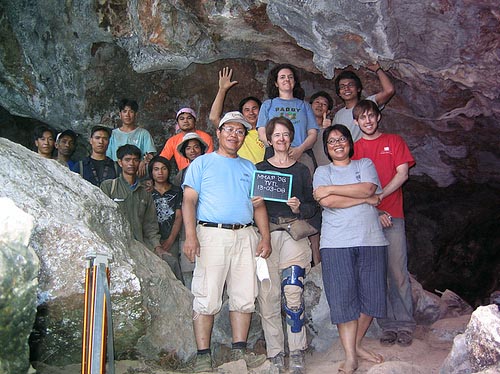 Korakot (Kot) Boonlop Researcher, Princess Maha Chakri Sirindhorn Anthropology Centre (SAC), Bangkok, Thailand
Korakot (Kot) Boonlop Researcher, Princess Maha Chakri Sirindhorn Anthropology Centre (SAC), Bangkok, Thailand
Sureeratana (Joom) Bubpha Lecturer, Thammasat University, Bangkok, Thailand
Bill Henderson Volunteer, University of Pennsylvania Museum, USA
Dr. Helen Lewis Lecturer, University College Dublin, Ireland
Onchansamone (Onchan) Ninethaphone Chief of Culture for Luang Prabang District, Department of Information and Culture, Laos
Kon Keo Phannasy Department of Information and Culture, Laos
Norseng Sayvongduoane Deputy Director, Department of Information and Culture, Laos
Souksamone Sonethongkham Exhibition Section, Vientiane National Museum, Laos
Yanik Ruiz-Ramón Student, University of Pennsylvania, USA
Sonexay Yasuli Exhibition Section, Vientiane National Museum, Laos
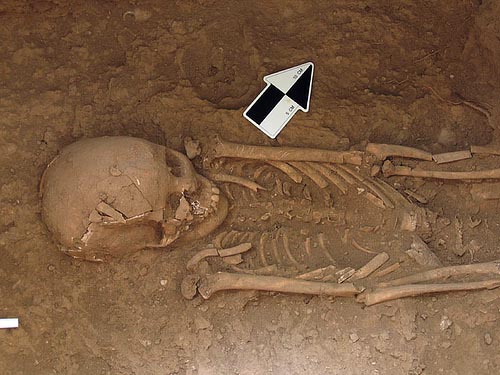 MMAP completed its first test excavation season in Laos in July 2007, two years after a remarkable survey season in 2005. Dr. Joyce White is more optimistic than ever that the region, a virtual terra incognita among archaeologists until now, holds great promise to provide important pieces to the puzzle of human habitation and settlement during Southeast Asian prehistory, a period reaching back into the late Pleistocene at least 20,000 years ago.
MMAP completed its first test excavation season in Laos in July 2007, two years after a remarkable survey season in 2005. Dr. Joyce White is more optimistic than ever that the region, a virtual terra incognita among archaeologists until now, holds great promise to provide important pieces to the puzzle of human habitation and settlement during Southeast Asian prehistory, a period reaching back into the late Pleistocene at least 20,000 years ago.
The 2007 test excavation site, Phou Phaa Khao Rockshelter, provided Dr. White and her team with new challenges, as she worked with an enthusiastic but variably-trained group of collaborators at this cave 30 miles of dirt road from Luang Prabang city—outside the range of cell phone signals or electricity—during the unpredictable rainy season.
Although there was no specific evidence to suggest this site was used during the middle Holocene period, the site had strong evidence of human occupation and settlement during both the stone age (10,000 to 5,000 years ago) and the iron age, sometime after about 3,000 years ago. Parts of seven human burials, more than 2,300 fragments of stone artifacts and manufacturing debris, and a variety of both earthenware and stoneware ceramics were excavated by the team.
For the next step, the MMAP team hopes to continue test excavations at additional sites on other tributaries of the Mekong River, looking particularly for Middle Holocene evidence, but carefully collecting whatever data is unearthed. The research will simultaneously deepen knowledge of the Lao archaeological record and train the next generation of Lao archaeologists.
2007 Team
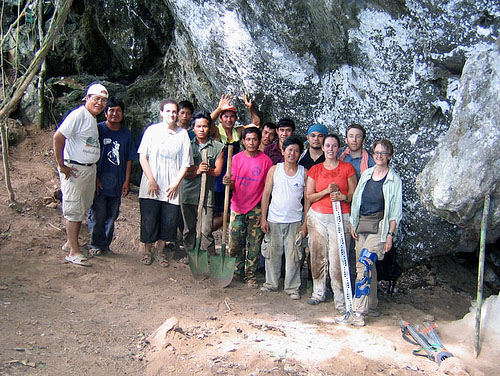 Olivia Given Ph.D Candidate, University of Pennsylvania, USA
Olivia Given Ph.D Candidate, University of Pennsylvania, USA
Dr. Helen Lewis Lecturer, University College Dublin, Ireland
Benjamin (Ben) Marwick Ph.D Candidate, Archaeology, Australian National University
Onchansamone (Onchan) Ninethaphone Chief of Culture for District of Luang Prabang, Laos
Norseng Sayvongduoane Technical Staff, Luang Prabang Department of
Information and Culture, Laos
Souksamone (Pong) Sonethongkham Exhibition Section, Vientiane National Museum, Laos
Konevilay Southedlus Staff, Culture Officer, Deptartment of Information and Culture, Luang Prabang, Laos
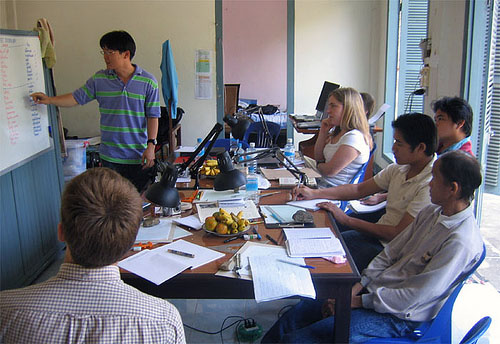 Much of archaeological research involves laboratory analysis, namely, tasks associated with recording and analyzing artifacts recovered from surveys and excavations of sites. The training objectives of MMAP overall include not only fieldwork (excavation and survey) but also training in archaeological laboratory analysis.
Much of archaeological research involves laboratory analysis, namely, tasks associated with recording and analyzing artifacts recovered from surveys and excavations of sites. The training objectives of MMAP overall include not only fieldwork (excavation and survey) but also training in archaeological laboratory analysis.
The training in MMAP 2006 focused on laboratory aspects of archaeological research, using the stone artifacts recovered during the site survey conducted by MMAP 2005. The specific plan for the MMAP 2006 season included developing skills in archaeological illustration, photography, data recording, and databases. Training was accomplished by lectures in Lao and Thai and intensive supervised hands-on work,primarily with stone tools. We worked with stone tools not only because many of the artifacts discovered in MMAP 2005 were of flaked stone but also because flaked stone tools represent the oldest tool technology recovered. Working with these tools would allow the trainees both to acquire basic skills in archaeological analysis and to build a foundation of knowledge in Lao prehistory. The Luang Prabang National Museum generously provided a room on the museum grounds for the MMAP team to use as a training laboratory.
Acknowledgements: The 2006 Survey season was supported by grants from the National Science Foundation, the National Geographic Society, and the University of Pennsylvania Museum.
2006 Team
 Dr. Katherine Arrell Lecturer in Geography, University of Leeds, UK
Dr. Katherine Arrell Lecturer in Geography, University of Leeds, UK
Olivia Given Ph.D. Candidate, Anthropology, University of Pennsylvania, USA
Benjamin (Ben) Marwick Ph.D Candidate, Archaeology, Australian National University
Sithpaseuth Phongchaleun Architect, Department of Museums and Archaeology, Vientiane, Laos
Bounyalit Savong Deputy Director, Fine Arts School, Luang Prabang, Laos
Norseng Sayvongduoane Technical Staff, Department of Information and Culture,
Luang Prabang, Laos
Souksamone (Pong) Sonethongkham Staff, Lao National Museum, Vientiane, Laos
Konevilay Southedlus Staff, Department of Information and Culture, Luang Prabang, Laos
Cholawit Thongcharoenchaikit Research Assistant, Highland Archaeology
Project, Thailand
 Read the blog: A Day in the Life of an Archaeologist: a Blog from Laos
Read the blog: A Day in the Life of an Archaeologist: a Blog from Laos- Watch the YouTube video: A Taste of Luang Prabang
- Read the article: MMAP 2005: An Expedition to Laos Through Museum Volunteers’ Eyes
In March of 2005, the first MMAP team arrived in Luang Prabang, Laos. In this lovely UNESCO World Heritage town, we established our base to begin a multi-year journey of archaeological and cultural discovery in a region virtually untouched by modern archaeological research.
The purpose of the 2005 MMAP Survey was to explore three river tributaries on the left (eastern) bank of the Mekong River in Luang Prabang Province, and to locate and record those sites with potential for future in-depth exploration and excavation. So much casual evidence already existed, from French colonial accounts to ancient artifacts sold in modern-day Lao markets, that MMAP archaeologists hypothesized that this area would have abundant evidence of prehistoric settlements, including stone age, neolithic, and metal age sites.
Our 2005 survey had to cover about 1500 square kilometers of sometimes rough terrain in less than a month, so we needed to be efficient with our time. Two separate teams did rapid surveys of the three tributaries of the Mekong River in Luang Prabang Province. Using mobile GIS (Geographic Information System) technology, along with digital photography, MMAP was able to evaluate data and do surface collecting from numerous potential sites, more efficiently than would have been possible with more traditional recording methods. Working with Lao local knowledge also made for efficient fieldwork. Village chiefs gave us permission to explore and they assigned villagers familiar with their areas to guide us to potential sites, and also (very important!) to keep us away from the unexploded bombs of the Vietnam War era.
The MMAP Survey returned with a rich variety of data. In only 21 days in the field, the team identified 57 sites with potential for further research. We also saw the grand openings of bilingual exhibits in Luang Prabang and Vientiane, which MMAP developed to explain our first-year efforts to Lao officials and stakeholders.
Acknowledgements: The 2005 Survey season was supported by grants from the National Science Foundation and the National Geographic Society.
2005 Team
The MMAP 2005 Survey Team was a collaboration of U.S., Lao, British, Australian, and Thai colleagues.
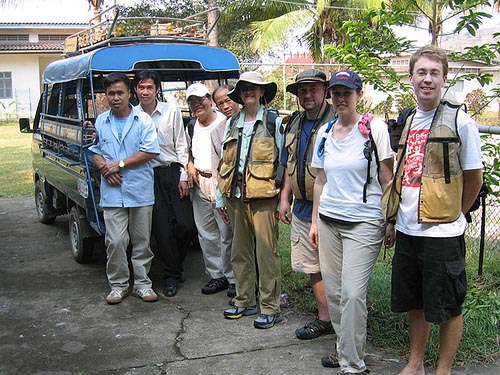 Dr. Katherine Arrell Lecturer in Geography, University of Leeds, UK
Dr. Katherine Arrell Lecturer in Geography, University of Leeds, UK
Korakot (Kot) Boonlop Researcher, Princess Maha Chakri Sirindhorn Anthropology Centre (SAC), Bangkok, Thailand
Olivia Given Ph.D. Candidate, Anthropology, University of Pennsylvania, USA
Bill and Barbara Henderson Volunteers, University of Pennsylvania Museum, USA
Shawn Hyla Senior Information Technology (IT) Specialist, University of Pennsylvania Museum, USA
Vanpheng Keophannya Deputy Director, Luang Prabang National Museum, Laos
Kanda Keosopha Division of Management, Department of Museums and Archaeology, Laos
Dr. Benjamin (Ben) Marwick Ph.D Candidate, Archaeology, Australian National University
Dr. Chureekamol (Soi) Onsuwan Eyre Ph.D. Candidate, Archaeology, University of Pennsylvania, USA
Bounyalit Savong Deputy Director, Fine Arts School, Luang Prabang, Laos
Konevilay Southedlus Staff, Department of Information and Culture, Luang Prabang, Laos
Beth Van Horn Volunteer, University of Pennsylvania Museum, USA
 In 2001, Dr. Joyce White undertook a quick assessment survey with Bounheuang Bouasisngpaseuth, an official at the Lao Department of Museums and Archaeology. They confirmed that Luang Prabang Province holds unusual potential for finding in situ prehistoric evidence.
In 2001, Dr. Joyce White undertook a quick assessment survey with Bounheuang Bouasisngpaseuth, an official at the Lao Department of Museums and Archaeology. They confirmed that Luang Prabang Province holds unusual potential for finding in situ prehistoric evidence.
In only three days, Dr. White saw signs of over 10,000 years of human occupation in a very small geographic area, including at least one potential habitation site, hundreds of polished stone adzes, and numerous ceramic and bronze artifacts.
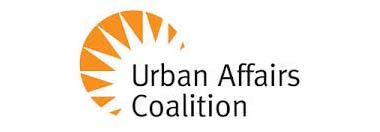
ISEAA is a program partner of the Urban Affairs Coalition (UAC), a nonprofit 501c3 entity. UAC administers funds raised by ISEAA, thus freeing us to focus on research and publication.

